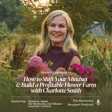
Ep.25 Blooming Success: Mastering Peonies and Sustainable Flower Farming with Melissa Hessney Masters, Tanglebloom
In this episode, Melissa Hessney Masters, of Tangleboom Flower Farm, takes us on a heartfelt journey that began with a simple yet profound desire to find local flowers for her wedding back in 2010. This quest sparked a passion that led her to establish Tanglebloom in 2013. As we delve into her story, you'll hear about the myriad challenges she faced in the world of flower farming and how she gracefully navigated them.
Melissa also shares her innovative shift towards Agritourism, a move that has not only diversified her farm's offerings but also brought the beauty of Tanglebloom to a wider audience. One of the highlights of our conversation is the creation of Vermont's very first flower CSA (Community Supported Agriculture) program, a testament to her pioneering spirit and commitment to community engagement.
Throughout our discussion, Melissa emphasizes her dedication to sustainable farming practices, a topic that resonates deeply with many of us. We also explore the undeniable charm and popularity of peonies, a flower that has captured the hearts of many. Melissa even offers a sneak peek into her comprehensive digital course on growing peonies, designed to equip you with the knowledge and skills to grow these stunning blooms successfully.
This episode is packed with valuable insights and practical cut flower advice that you won't want to miss! So, grab your garden tools, find a cozy spot in your garden, and tune in to hear the full conversation with Melissa from Tangleboom.
In This Episode You’ll Hear About:
- Melissa's journey to flower farming (00:02:30)
- Starting a flower CSA (00:07:18)
- Transition to agritourism and education (00:14:30)
- Focus on peonies and perennials (00:17:23)
- Agritourism and Glamping (00:22:48)
- Niche Down to Peonies (00:26:11)
- Lessons Learned and Challenges (00:33:00)
- Peony Growing Tips (00:36:56)
- Favorite Peony Varieties (00:42:57)
- Controlling botrytis and other diseases (00:49:08)
- Harvesting peonies and preventing thrips (00:57:52)
- Relocating and dividing peonies (01:02:25)
- Harvesting peonies in the first season (01:03:38)
- Harvesting and Marketing Strategy (01:04:49)
- Peony Course (01:07:44)
Show notes: https://thefloweringfarmhouse.com/2024/06/15/ep-25-growing-peonies-with-tanglebloom-farm/
Learn More About Melissa & Tanglebloom:
- GrowAndSellPeonies.com - The Peony Course
- Tanglebloom.com - Learn more about Tanglebloom Flower Farm & Stays
- @tanglebloom - Follow on Instagram
***Rate, Review, & Follow The Backyard Bouquet***
If you enjoyed this episode, will you please consider leaving the podcast a review? Your review helps make the podcast more discoverable to others and allows me to continue creating more episodes. I'd love to know what you enjoyed most about the episode.
New episodes every Tuesday to help keep your garden blooming!



















